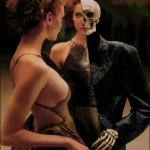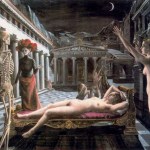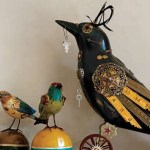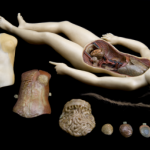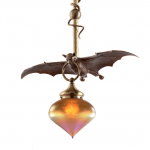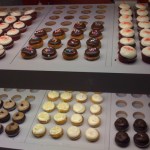Wonder Cabinets
Richard Avedon, The New Yorker, 1995
Via Haute Macabre, an unbelievable fashion editorial created by Richard Avedon for the New Yorker. I have no words.
Richard Avedon, The New Yorker, 1995
See the complete editorial at Haute Macabre.
The Sleeping Venus (1944)
Paul Delvaux
Observatory is a new collaborative art space located in Brooklyn, where it is reportedly sandwiched between Proteus Gowanus, Cabinet Magazine, and the Morbid Anatomy library. Its illustrious proprietors include Pam of Phantasmaphile, Joanna of Morbid Anatomy, and D&M of Curious Expeditions. And if that's not reason enough to be excited, tonight they are hosting a talk by Kathryn Hoffmann of the University of Hawaii at Manoa, entitled "Reveries of Sleeping Beauty: Slumber and Death in Anatomical Museums, Fairground Shows, and Art."
I saw Dr. Hoffmann…
Once out of nature I shall never take
My bodily form from any natural thing,
But such a form as Grecian goldsmiths make
Of hammered gold and gold enamelling
To keep a drowsy Emperor awake;
Or set upon a golden bough to sing
To lords and ladies of Byzantium
Of what is past, or passing, or to come.
--WB Yeats, "Sailing to Byzantium"
My coveted bauble of the week is this fabulous, foot-high Gladiator Raven from Anthropologie. Maybe it's not hammered gold and gold enamelling, but the patina and quirky textures in this piece should satisfy any ephemeraphile with $648 to spare.
Wax anatomical figure of reclining woman, Florence, Italy, 1771-1800
Science Museum London
Starting today, the Wellcome Trust and sciencemuseum.org.uk open a brand spanking new collection of medical history archives. "Brought to Life: Exploring the History of Medicine" is searchable by people, place, thing, theme, and time. You can view a timeline of medical history in Europe next to similar timelines for the Islamic empire, Egypt and Greece (I do wish China and India were as prominently placed). You can read essays about larger questions, like what "wellness" means, or play with a cool…
Yup, that's a flying bat gripping a lamp in its mouth, with his buddy, a coiled snake, crawling along above him. And it's not a faux-Victorian, nouveau-Goth creation - it's a replica of an actual late 1800s fixture, by eclectic lighting company Rejuvenation. Seriously - over a hundred years ago, someone thought this was the greatest lamp evah! I'm not sure I'd actually choose the Dracula-esque Drake fixture for myself, mind you; not only is it more than $2K, I think you need a very special space for this 45" long creation. Like a living room designed by Edward Gorey. But if you've got that…
Essays are like cupcakes: they're tasty, abundant, idiosyncratic, and small enough to finish without feeling you've overindulged - which leaves you vulnerable to the self-deception that just one more is a good idea. So here are some weekend reading suggestions for a lazy Sunday.
--At SEED, Carl Zimmer's love letter to natural history museums as functional wonder cabinets:
Gradually, royalty's cabinets of wonders turned into libraries of flesh and rock, where scholars could research the workings of the world. Ole Worm, a 17th-century anatomist, became famous for his collection of narwhal…
Courier
mixed media, 2007
Thomas Doyle
Thomas Doyle's miniature sculptures are dead ringers for the moldering houses and threatening forests of HP Lovecraft's Arkham. Each 1:43 scale vignette is like a scene from a horror film - if horror films were staged in the lovingly crafted O-scale countryside of a miniature railroad diorama!
Acceptable losses
mixed media, 2008
Thomas Doyle
I discovered Doyle's work via party like an art star, the blog of art gallery manager Chloe Gallagher. As Gallagher notes, the tiny scale of Doyle's pieces draws you intimately in, while the glass domes act as a…
The Pigeon of Passage
The Natural History of Carolina, Florida and the Bahama Islands, 1754
Mark Catesby
Unlike Benjamin Button, he's not up for an Oscar, but he's also a film star - several hundred years late. Mark Catesby (1683-1749), a forerunner of Audubon, was the first European scientist/artist to document the flora and fauna of North America. He depicted live specimens in their natural habitats, and made special study of both migration and extinction. You can view Catesby's masterwork, The Natural History of Carolina, Florida and the Bahama Islands, Vol 1 and Vol 2, at the University…
Okay, there are only a few days left to vote for Curious Expeditions in the 2008 Weblog Awards! M and D really deserve recognition for their amazing, eclectic travelogues, so if you're a fan, please go vote for them - and if you're not a fan yet, check them out.
These charming photos by bre pettis capture a lovely, detailed diorama at the Natural History Museum in Vienna. I'm not sure how old it is, but it's very cool.
Ephraim Chambers
Cyclopaedia, 1728
Via Morbid Anatomy, some beautiful detail images from Ephraim Chambers' Cyclopaedia:
Cyclopaedia: or, A Universal Dictionary of Arts and Sciences (folio, 2 vols.) was an encyclopedia published by Ephraim Chambers in London in 1728, and reprinted in numerous editions in the 18th century. The Cyclopaedia was one of the first general encyclopedias to be produced in English. (source: Wikipedia
Read more at Morbid Anatomy.
Tarantula
Elizabeth Goluch
sterling silver, gold, tourmaline
Canadian artist Elizabeth Goluch's precious metal insects double as treasure-boxes. From her website:
My fascination with nature in general and with insects in particular began while I was a child growing up on a farm in southwestern Ontario. The work that I do reflects the influence of that environment -- the wildlife and the insects, as well the intricacy, the complexity and the order inherent in nature. I am drawn to the beauty, but also to the danger in nature. I relish the visible, yet can imagine much more; which gives rise…
Wall of Fishes, Vanderbilt Museum
from Curious Expeditions
Nothing symbolizes the amateur naturalist's aesthetic as well as a wall of preserved specimens in glass jars, like the jewellike Wall of Fishes in the Vanderbilt Museum (captured here by the wonderful Curious Expeditions, in a fascinating slideshow treasure gallery of the Vanderbilt).
A similar glistening room of glass is found in my revious post about London's Hunterian Museum.
The problem with historical specimen collections like these is that slowly but surely, they're falling apart. Storing biological tissue in alcohol or…
This article originally appeared on the old bioephemera September 9, 2007.
Syphilitic skull with three trephine holes and osteomyelitic lesions
Hunterian museum
One of my favorite London experiences was my visit to the Hunterian museum. If only I had more time there! I liked it so much, I returned on my last day, procrastinating my departure for Heathrow as long as possible.
The Hunterian is tucked away inside the Royal College of Surgeons of England, on Lincoln's Inn Fields. In its Victorian incarnation, it was a wonderful multi-tiered gallery with railings, balconies, and suspended…
Fixed (fawn)
Lisa Black
Lisa Black's hybrid clockwork animals are heartbreaking - especially the fawn and duckling. The title of her series, "Fixed," strikes just the right note of ambiguity. Is the fawn's state a travesty, or better than the alternative? Who did the fixing, and why?
Via Brass Goggles
PS - speaking of Goggles, have you seen Google's new Mail Goggles? It's an add-on for Gmail which is supposed to prevent you from sending drunk email messages late at night, by requiring you to do math before allowing you to send. The only problem is, the math looks too easy - I'm terrible at…
Before heading to the Apple Store SoHo for our blogging panel last Wednesday, I dropped by evolution ("science and art in SoHo"), a store recommended by Pam of Phantasmaphile.
Evolution is clearly NYC's prime destination for the amateur natural historian, an east coast cousin of Berkeley's Bone Room. They offer skulls (real and replica), butterflies and beetles in cases, minerals, shells, memento mori carvings, skins, ammonites, coprolites, meteorites, tusks, teeth, arrowheads, and other things one never dreamed one needed. A sphere of elemental copper? Natural hematite magnets? A wallet…
fanfin seadevil
The Deep: Extraordinary Creatures of the Abyss
Claire Nouvian
photographed by David Shale
For anyone who does not yet have a copy of Claire Nouvian's beautiful book, The Deep, here's a chance to win it - through Oceana's Freakiest Fish of 2008 contest. The book also has the Dumbo octopus in it. Is the Dumbo octopus' cuteness the perfect antithesis of the fanfin's hideousness? Would they annihilate each other if they collided? Discuss!
dumbo octopus
The Deep: Extraordinary Creatures of the Abyss
Claire Nouvian
photographed by David Shale
Today is the first day of the annual DonorsChoose Blogger challenge! As you may know, DonorsChoose is a website devoted to funding lessons dreamed up by creative (but underfunded) teachers. Everyone knows that teachers routinely spend their own time and money to create inspiring experiences for their students - and that those teachers don't get paid nearly enough to give their classes everything they need.
That's why i'm asking you, readers and friends, to help fund the bioephemera Classroom of Curiosity Challenge. Inspired by the Cabinet of Curiosities theme, the requests in my challenge…
Pam at Phantasmaphile has just written an MSN travel guide for the incorrigibly curious, called "An Old-World Sense of Wonder." Pam kicks off her list of wonder cabinet destinations with three NYC shops I plan to visit next month: Obscura Antiques and Oddities (280 East 10th Street), de Vera (1 Crosby Street), and Evolution (120 Spring Street). Yum!
Fortunately for me, de Vera and Evolution are just a few blocks from the Apple Store SoHo, where I and four of my Sciblings will be doing a science blogging panel October 1. If you're in NYC that evening, please stop by - Apple's a great venue,…
19th century anatomical study cabinet #1
Alex cf, 2008
The undisputed modern master of the horrifying cryptozoological specimen is Alex cf, bane of vampires and cthulhu spawn. Unfortunately, there's an immense demand for his work, and he isn't very prolific. So how's a girl to fill her curiosity cabinet - especially with Halloween right around the corner?
Luckily, Repository For Bottled Monsters turned up a great DIY project: how to bottle your own mad-scientist monstrosities. Check out these jars, created using inexpensive plastic toys from the dollar store:
from imakeprojects.com
These…
